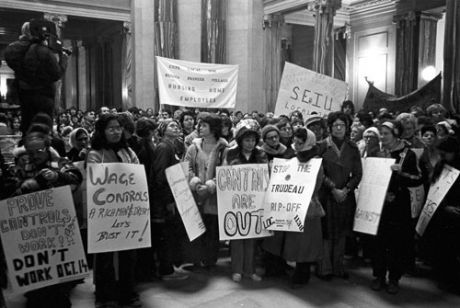Columns
You are here
From Pierre to Justin Trudeau: challenging corporate Canada

November 4, 2015
The great American architect Frank Lloyd Wright got his start designing homes and public buildings in the Chicago suburb of Oak Park. I recommend the audio-guided tour of the neighbourhood. Some of the recorded commentary is from Wright himself; including his description of a home he designed in 1939, as a response to the rise of fascism. His idea was to build windows in all the corners, to cast light into the dark places and expose the threat. On tape, Wright almost sighs: “Then I discovered you can have corner windows and fascism too.”
Which brings me to Justin Trudeau and the Liberal election victory. Here is what I have been hearing since the vote: yes, every Liberal government ever elected in Canada has ended up screwing working people. But this Justin fellow seems awfully nice so let’s just give him the benefit of the doubt, spot him a couple of years to undo the Harper damage, and hope for the best. Everything seems much brighter!
Sunnier conservatism
Justin Trudeau is the corner window of Canadian politics. I’m not saying that Trudeau is a fascist. I don’t think Harper was a fascist either. The creeping threat of fascism comes from the ascent of corporate power, a power that can take more or less belligerent forms.
As repellant as Harper was, he was never the main enemy. It was the rule of corporate interests–specifically the oil and gas industry–over our democracy. To think otherwise is to agree with the even more repellant Jason Kenney, that the problem with Harper was one of “tone.” “We need a conservatism that is sunnier and more optimistic than we have sometimes conveyed,” opined the erstwhile Defence Minister and would-be Grand Inquisitor.
Justin Trudeau is that sunnier and more optimistic conservatism. For me the most telling moment of the election campaign was the resignation of Trudeau’s campaign co-chair, Dan Gagnier. Gagnier has a long history working with and for the oil industry; he was caught advising his petro buddies as to the best ways to influence a new Liberal government.
An investigation by journalist and petroleum industry critic Andrew Nikiforuk, in The Tyee, documents close connections between Gagnier and Bruce Carson. Carson is the disgraced Harper advisor now on trial for illegal lobbying and influence peddling.
Both were vice-chairs of the Energy Policy Institute of Canada (yes people, this is an EPIC scandal). While Carson served as aide and senior advisor to Harper for years, Gagnier was a senior advisor to the Chretien Liberals.
The essence of the incoming Trudeau regime will not differ from the essence of the outgoing Harper gang. And the scandals that will inevitably pull it down will be the same too.
Pierre Trudeau
I have lived under Liberal governments most of my life, and it is their treachery that sticks in my mind. Indulge me, as I tell you a tale of the dim, distant Liberal past.
It is well known that Pierre Trudeau manufactured a terrorist crisis in 1970, imposed martial law in the form of the War Measures Act, and used it to criminalize not only advocates for Quebec nationalism, but trade union activists across the country.
In the 1972 election the Liberals were reduced to a minority government The NDP, led by David Lewis, won 31 seats, and used their balance of power to prop up the Liberals for two years. In 1974 they and the Tories forced a new election. The NDP had dreams of taking advantage of a wave of militancy sweeping the country.
In the background was a combative Canadian working class with a magnificent record of striking to win better pay and working conditions. Hard as it may be for today’s activists to believe, Canada led western nations in strike days “lost,” wildcats were common and solidarity between public and private sectors was the order of the day. This climaxed in 1972’s Common Front strikes in Quebec, which essentially paralyzed the province and saw workers temporarily take over industry, media and entire towns.
In the 1974 election campaign, the Progressive Conservatives, led by Robert Stanfield, campaigned on a plan to impose wage and price controls to break the momentum of the unions. Pierre Trudeau based his whole campaign on opposing wage and price controls. He ridiculed the dour Stanfield and out-flanked the plodding Lewis. The call went out for strategic voting, and workers abandoned the NDP to support Trudeau as the best bet to stop laws limiting wage increases.
Trudeau regained his majority. The NDP lost half its seats. Within a year Trudeau imposed the very wage and price controls he had campaigned against. Legal limits were imposed on public employees and workers in large-scale industry.
The Canadian Labour Congress huffed and puffed. It organized a Day of Protest in October 1975, an attempt at a national general strike. Hundreds of thousands of workers walked out.
But Trudeau called the CLC’s bluff. There was no strategy or will to sustain the fight, and the protests fizzled. That marked the beginning of the decline in union organization in this country, and with it a decline of working and living standards that continues to this day.
The lesson is this: don’t by dazzled by Justin Trudeau’s sunny, corner-window style. When push comes to shove on the issues that really matter–climate change, funding public services, restoring civil liberties and scrapping imperialism abroad–he is going to stab us in the back. Not because he is a bad guy, but because the corporations that control him (and controlled Harper, Chretien, Mulroney and Trudeau , et cetera ad nauseam) require it.
And until we come up with a fight-back organized from the ground up, not from the top down like the CLC’s 1975 dog and pony show, they will continue to get away with it.
Section:










